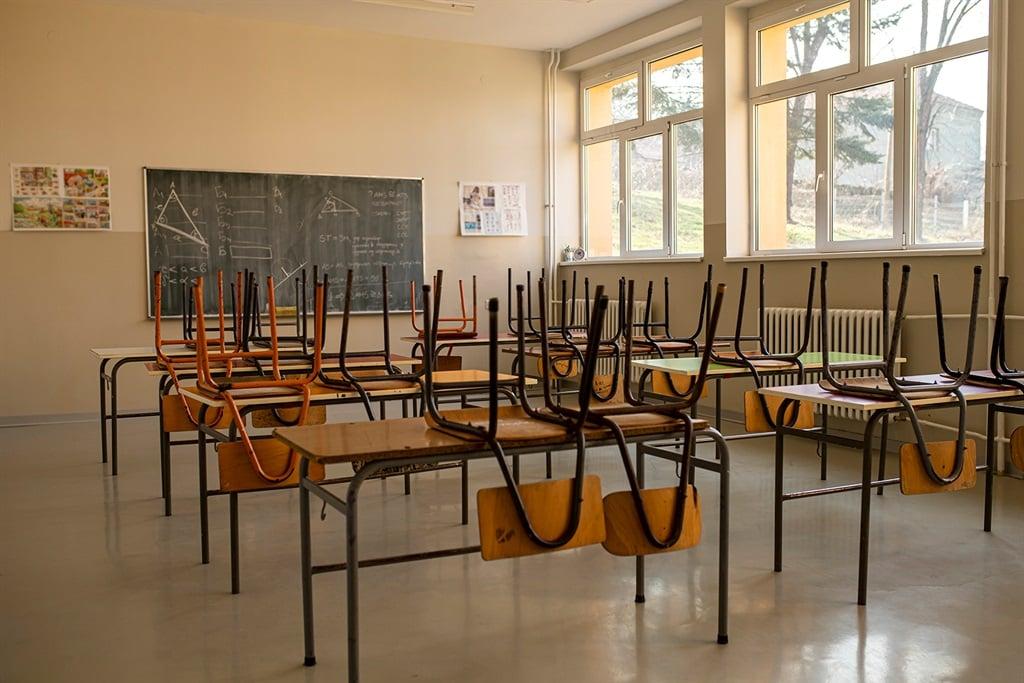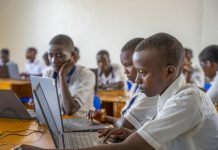Africa-Press – South-Africa. Despite the numbers of schools damaged by storms and floods each year, the Department of Basic Education – and expenditure allocated to basic education from Treasury – has overlooked climate change, write Tshidi Lencoasa and Julia Chaskalson.
School buildings destroyed by storms and floods, classrooms that are overheated and overcrowded – these conditions characterise many schools in South Africa’s rural areas. Already hamstrung by decades of unequal education spending and infrastructure provisioning, the worsening climate crisis impacts the realisation of basic education in South Africa.
A report by the Intergovernmental Panel on Climate Change (IPCC) characterised the country as a climate change hotspot, and we are already observing the increasing occurrence of extreme weather events. The South African school system is particularly vulnerable to these events, with the state of infrastructure reflecting historic inequality where most impoverished pupils are subjected to poor and unsafe learning infrastructure built with inappropriate materials.
There is a risk that climate change will exacerbate the already unsafe and unlawful conditions of schooling which is widespread in South African schools, with poorly constructed schools, or schools made from inappropriate materials like mud bricks, being damaged further by extreme weather.
Not a remote future problem
Despite the numbers of schools damaged by storms and floods each year, the Department of Basic Education – and expenditure allocated to basic education from Treasury – has overlooked climate change. By failing to be responsive to climate change, basic education and finance authorities are kicking a can down the road, at the expense of current and future learners’ rights to equality, dignity, basic education and a safe learning environment. With school infrastructure being damaged by extreme weather at a rate faster than government is planning for and delivering repairs, more generations of learners will likely experience classroom overcrowding as school buildings become unusable.
This is not a remote future problem. Already, climate change is wreaking havoc in school environments around the country.
In December 2021, 32 schools were damaged by the floods that devastated some areas in the Sekhukhune and Capricorn districts in Limpopo. Since then, outcry over the delay in repairing these damaged schools ensued. Following this, in April 2022, floods in KwaZulu Natal affected 630 schools and 356 of those still need to be fixed. Floods in the Eastern Cape damaged 51 schools. Floods like these and other extreme weather events are expected to become more prevalent in the face of a worsening climate crisis.
Section27 works with schools in Limpopo that have been affected by extreme weather events and experience overcrowding due to inadequate numbers of safe classrooms. For example, Ndzalama Primary School in Giyani cannot use a block of four classrooms because its roof was ripped off in storm damage 10 years ago.
A 2018 storm caused more infrastructure casualties, with the roof and walls of another block of classrooms cracked and damaged. With one block of classrooms completely unusable, and another prone to leaking when it rains, effective teaching and learning at Ndzalama is not possible in certain weather conditions. Classes at Ndzalama become very overcrowded, sometimes reaching upward of 80 learners in one class.
Schools like Bvuma Primary School, Chameti Secondary School and Dingamanzi Primary School experience similar infrastructure challenges and have been impacted by extreme weather, contributing to classroom overcrowding and poor educational outcomes. When speaking with school communities, it was not uncommon for educators to explain they would have to call off lessons if it looked like storms were approaching.
Learners described anxiety about learning at schools where damage to infrastructure left wiring and structural beams exposed and unstable. Many remarked that the heat in mud-brick classrooms, or the sound of rain on corrugated iron roofing, made it impossible to learn. The right to basic education means very little in conditions where infrastructure (and climate change) interferes so perniciously with the ability of teachers to teach and learners to learn.
Spending allocations
Although all of these schools have infrastructure which does not comply with school infrastructure regulations, projects to upgrade, repair or refurbish their infrastructure were all suspended during Covid-19 and have not been resumed since. Continued extreme weather events only makes the infrastructure at these schools even more dangerous and unconducive to effective learning.
Following years of urgent pleas from the school governing bodies of each of these schools, and no action from education authorities, Section27 initiated litigation on behalf of Ndzalama and other schools that remain without the infrastructure they need.
Fiscal policy and spending allocations have the power to address the impact of climate change on public infrastructure directly, equipping schools to be climate resilient and protecting the right to basic education for learners in the country, particularly those most vulnerable to interrupted schooling owing to climate change. In the 2022 Medium Term Budget Policy Statement (MTBPS), National Treasury acknowledged this, reflecting that the country needs to “improve its resilience to extreme weather”.
Unfortunately, the budget trends have been characterised by spending allocations that underestimate the financial resources required to provide safe and climate-resilient school infrastructure in the country. The Education Infrastructure Grant (EIG), which is ring-fenced to ensure school infrastructure is safe and adheres to the Minimum Norms and Standards for School Infrastructure, has been characterised by dwindling spending allocations.
Rhetorically, Treasury claims to increase spending to “enhance the quality of public services such as education”, but when revised rates of inflation at 6.7% are considered, the real value of infrastructure funding is eroded and provincial education departments have restricted financial resources to protect the most vulnerable learners from overcrowding and its associated negative educational outcomes.
Band aid
As an adjustments budget, the MTBPS 2022 was an opportunity to correct this and bolster the school infrastructure budget. Although there were nominal increases in education spending, these increases do not match the pace of basic education inflation – estimated at 8.5% annually over the past decade.
The EIG has been revised upwards by R116.8 million to allocate R22 million of additional funding to the Eastern Cape and R95 million to assist KwaZulu Natal in 2022/23 to assist with the repair and maintenance of schools affected by floods earlier this year.
Although increases are welcomed as emergency relief is desperately needed at schools in these provinces, our analysis indicates that this help underestimates the extent of the problem.
An August 2022 progress report by the Auditor General on the implementation of repairs of schools damaged by the floods in KZN identified 356 schools needing repairs and estimated the total cost of these repairs to be R235 million. With this costing in mind, the MTBPS only allocates enough additional funding to support 144 repair projects at flood-impacted schools, only meeting less than half of the reported need for school repairs and refurbishments.
Other costing data from the Department of Basic Education in October 2022 shows that, on average, school maintenance or repair projects cost R26 million per school, which would mean that the additional funding could only support nine repair projects. Some schools in KZN and the Eastern Cape may – as schools in Limpopo have done – have to wait for funding to be made available for infrastructure repairs that they need.
These costing estimates suggest that Treasury’s response to the impacts of climate change on school infrastructure is little more than a band-aid on a wide wound, not supporting comprehensive climate resilience.
Adequate sanitation
In addition to classroom infrastructure, the climate crisis will increasingly affect water security and quality at schools. Most water-borne bacteria causing infections thrive in warmer temperatures like South Africa’s climate, making the nearly 6 000 South African schools which have an unreliable water supply and over 5 000 which still have pit toilets vulnerable to outbreaks of infection. For schools to be climate-resilient and healthy learning environments, it is important that financial resources are directed to equipping them with adequate sanitation and eradicating pit latrines.
But trends with education spending over the past few years do not reflect promising outlooks for equipping the sector to handle these challenges. Research by the Public Economy Project at the University of the Witwatersrand has found that basic education spending has been reduced from R20 000 per learner in 2009 to a mere R16 500 per learner by 2021, in real terms since 2015. The research estimates that if the current trajectory of “fiscal consolidation” continues, real spending per learner could fall to R14 000 per learner per year.
In addition to the quantum of education spending in South Africa, underspending continues to plague provincial budgets, which UNICEF has attributed mainly due to supply chain management problems (procurement) and pressures associated with cash flow challenges. Equal education has reported that government spending per learner on basic education decreased by an average of 2.3% between 2009 and 2018. In the context of worsening climate crisis, underspending on basic education compromises the ability of the Department of Basic Education and the Provincial Education Departments to realise learners’ right to basic education. As provincial education departments develop their annual spending plans for 2023, it is important that these factor in adaptations to climate change.
In the face of an ensuing climate crisis, the South African school system must be equipped with the ability to mitigate its threat to education attainment through improved quantity and quality of spending. The effects of climate change on basic education infrastructure must be costed by Treasury and the Department of Basic Education, with inputs from civil society, so that we “climate-proof” schools for both current and future learners.
– Tshidi Lencoasa is a Budget Researcher at Section27. Julia Chaskalson is a Research and Advocacy officer at Section27.
*Want to respond to the columnist? Send your letter or article to [email protected] with your name and town or province. You are welcome to also send a profile picture. We encourage a diversity of voices and views in our readers’ submissions and reserve the right not to publish any and all submissions received.
For More News And Analysis About South-Africa Follow Africa-Press






